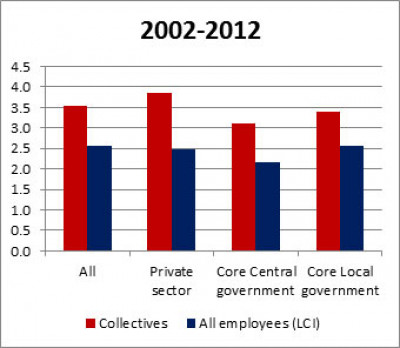It is widely acknowledged internationally that collective employment agreements give better pay increases than individual agreements for most employees. They go some of the way to correcting the imbalance of power between employees and employers. This is acknowledged in the Employment Relations Act.
By Bill Rosenberg

How much better are collective employment agreements? The Industrial Relations Centre (IRC) at Victoria University collates these agreements, and here we will look mainly at those in the state sector.
Coverage
In the year to June 2012, 308,900 employees were covered by collective agreements, an increase of 5,200 or 1.7 percent in the year – faster than the 0.4 percent growth in employee numbers in the workforce. Union membership was 379,185 in March 2012.
In 2012, 41 percent of employees on collectives notified to the IRC were on multi-employer collective agreements (MECAs), the rest being single-employer collective agreements.
Multi-employer bargaining is concentrated in the public sector, with 65 percent of what the IRC calls core government employees covered by a MECA.
The also IRC notes that the public sector has about 20 per cent of New Zealand’s employees – but 60 per cent of employees covered by collectives. Government attacks on collective bargaining will therefore particularly hit state sector employees.
Pay
In 2012, the IRC could calculate wage movements in 857 collectives covering 205,395 employees, of whom 56 percent were in the public sector (education accounts for 35 percent alone). So the overall average pay outcomes it reports heavily reflect what has been happening in the public sector rather than across the whole labour force.
The average annualised wage increase in collectives in the year to June 2012 was 2 per cent compared to 2.6 per cent in 2011. In 2010 it was 4.2 per cent, though probably a hangover from multiple-year agreements made before the global financial crisis hit.
The best official statistic to compare this with is the Labour Cost Index (LCI). This includes increases from changes in both individual and collective agreements, but not increases for individual performance, skills or experience. There are also LCI measures for public and private sectors, which we will use for comparison, though they may not exactly match definitions used by the IRC.
The LCI for all employees showed a 2.0 per cent increase over the same period. However it showed only 1.6 per cent for the central government sector, 2.4 per cent in local government and 2.1 per cent for the private sector.
By comparison, the collectives increased 1.4 per cent in the core government sector, 4.4 per cent in the government trading sector, 2.5 per cent in core local government, and 2.7 per cent in local government trading. Wages in private sector collective agreements rose 2.6 percent.
On the face of it, collective and LCI increases don’t look very different in 2012. This is a break from previous years and is heavily influenced by low increases in the state sector.
Going back 10 years, to 2002, all wages measured by IRC rose on average at the rate of 3.5 per cent per year, while the LCI rose only at a 2.6 per cent rate; core government services collectives rose by 3.1 per cent per year while the LCI rose only at 2.2 percent; core local government services collectives rose 3.4 per cent per year while the LCI rose at only 2.6 percent; and private sector collectives rose by 3.8 per cent annually while the LCI rose at only 2.5 percent.
These are significant differences in pay rises. A $10 wage in 2002 rising at 3.5 percent per year for 10 years would be $14.20 in 2012, but rising at 2.6 percent would be only $12.90, 9 percent less.
Another significant difference is that most employees on collectives get a general pay rise each year.
According to the LCI survey, 43 percent of employees did not receive a general wage or salary increase in the year to June 2012. The number was as high as 56 percent in late 2009.
However for people on collectives, the percentage receiving no increase has been in single figures since 2003 apart from 2012 when it was 11 percent.
Not only do employees on collectives receive higher pay increases, but they receive them more consistently.
This article is from the December 2012 issue of the PSA Journal.









